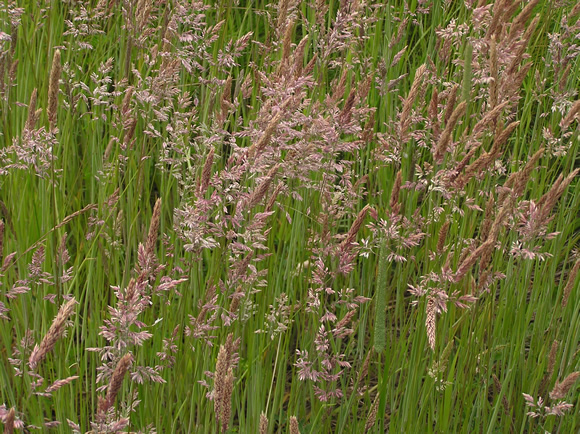A Touch of Grass. |
| |
|
| |
There are so many grasses that we walk on, walk over or walk through, and except for the odd one, never notice them. Like the wildflowers, the casual stroller never notices the grass until the blooms appear. |
|
|
|
Grass is very similar to the wildflowers, noticeable only when flowering, although the taller grasses may be noticed when the flower heads sway in the wake of the slightest breeze.
|
|
| |
The image above shows the natural beauty of Smooth Brome, Bromus racemosus, which we all take for granted, in fact we ignore it. It's a tall grass that can reach four feet in height. The florets of this grass are mostly small, closed and self ferterlizing. |
|
Above we have the Annual Meadow Grass, Poa annua. an annual that roots at the nodes and forms small mats. It is very common in disturbed sites and open habitats at low elevations. It is most suitable for lawns and is used on many golf putting greens. |
|
| |
|
|
Sweet Vernalgrass, Anthoxanthum odoratum, is a tufted and sweet scented perennial grass that has adapted well to many different habitats. It can be found in pastures and open forests and the sides of roads. It does however grow better in the drier climates of it's established locations. |
| |
|
| |
| This is the grass that children pulled the flower heads of and threw them at the backs of their friends like darts, where they would cling to their clothing. It is called Wall Barley, Hordeum murinum. The flowers have both male and female parts and are pollinated by the wind. It can't grow in shade and requires well drained soils. |
| |
|
| |
Bristly Dogstail Grass, Cynosurus echinatus, is another tufted annual grass that enjoys the openess of clearings, the meadows and the edges of the forests. It is less than two feet in height but is rather attractive and prefers the lower elevations. |
|
|
A strange name for a grass is Yorkshire Fog, Holcus lanatus, it is a tufted, perennial grass and is well adapted to growing in wet conditions but can also survive a moderate drought. |
|
|
|
|
|
|
A world wide grass introduced to North America as a hay crop is Orchard Grass, Dactylis glomerata. and grows to four feet high. It is a good looking grass and it is strange how many gardeners plant horticultural grasses and would remove this one. It is also the only plant in the genus Dactylis. |
|
|
| |
One of the rarer grasses of the North-west area is the Nodding Semaphore Grass, Pleuropogon refractus, shown here in three images. It is native to California but is found outside of the state but is confined to the west. |
| |
 |
|
This is one grass that cannot be mistaken for any other. It is not often found despite its wide range and it usually occurs in small colonies. It is a grass of seasonally wet and partially shaded sites. It is often found at the side of raods where ditches are dug for the winter snows and the water gathers in the spring.
|
|
|
|
| |
Sheep's fescue is also called Rocky Mountain fescue, Festuca ovina, It is a tufted narrow leaved perennial and can be found on dry outcrops and rocky slopes at the edge of forest areas. |
| |
|
|
| Drooping Wood Reed, Cinna latifolia. is found in moist woods and meadows also along stream banks and on disturbed sites it increases tremendously. |
| |
|
| |
The species name, latifoli comes from the Latin latus, broad, and folium, leaf. because of the wide leaves of this handsome grass. It is a sweet scented perennial that grows from 2 to 5 feet high. |
| |
|
| |
Bulbous Bluegrass, Poa bulbosa ssp vivipara, is an introduced perennial plant. It's habitat is disturbed sites at low elevations and in relatively dry conditions. |
| |
|
|
| |






















